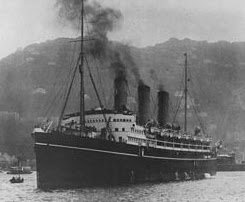I have been a resident of Vancouver for 37 years and two more generations have been added to our family tree with a total of five.
This connection to China had brought my husband's family to Vancouver.
The CPR established their headquarters in the Terminal Building downtown next to Pier BC, the dock for the Empress ships.


Today its is alive with the connecting passengers to the Skytrain.
 The Skytrain has 47 stations on three lines; Expo line, Millennium Line and Canada Lines.
The Skytrain has 47 stations on three lines; Expo line, Millennium Line and Canada Lines.

The CPR or Canadian Pacific Railway was expanding and added new ships, Canadian Pacific Steamships to their route to connect to China.
These were tea clippers that raced across the Pacific to get to Vancouver to off-load their cargo. It was then transported across Canada on their privately funded railways, to ports in the east. Their final destination was London, England.
These ships built in Glasgow, Scotland with the Empress of Russia being one of them. The Empress of Russia was built 1912-1913 and left on her maiden voyage leaving Liverpool via Suez to Hong Kong and Vancouver. She repeatedly sailed the same route, Hong Kong-Shanghai-Nagasaki-Kobe-Yokohama to Vancouver. In 1913 she broke the record for the fastest trans-Pacific crossing, which was formally held by the Empress of Japan. The Empress of Asia broke that record in 1914, crossing the Pacific in nine days, two hours and fifteen minutes.
The route was so successful that two more ships were added o the fleet. The 165,810-tonne vessels had a length of 570 feet and their beam was 68 feet. The ship had three funnels, two masts, quadruple screws and was able to reach an average speed of 19-knots.
The ocean liner provided accommodation for 284 first class passengers and 100-second class. There was addition room for 800 steerage class passengers.

These ships had a change in design from a long overhanging bowsprit to a straight stern like a warship.

This new design gave more speed and better seagoing qualities.

Empress of India figurehead 1936

















































